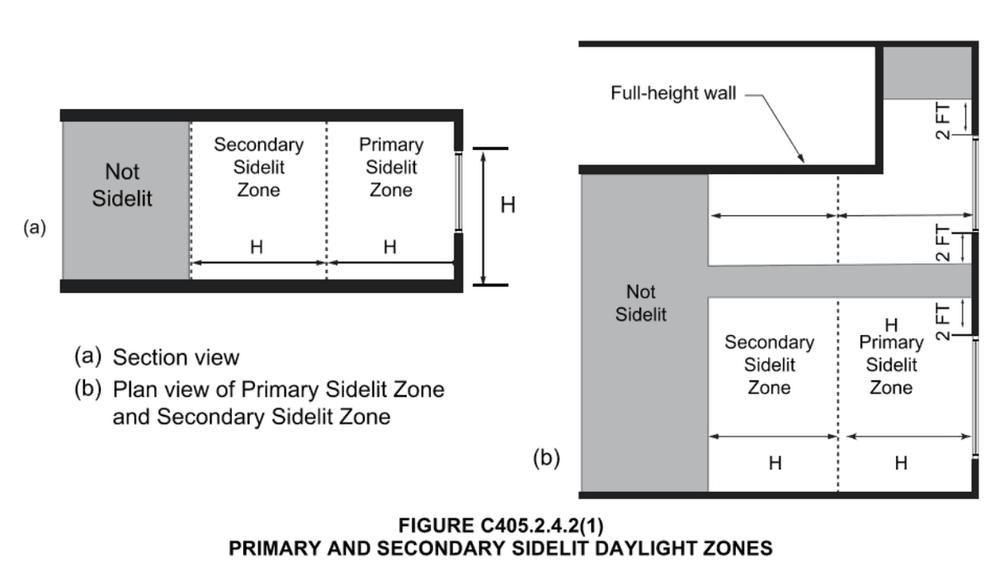MH Controls Corner: 2021 IECC Lighting Controls Updates
Every three years we look forward to what the International Code Council will come up with for the new iteration of the International Energy Conservation Code. At the end of January 2021, the latest version of the IECC was published and made available, and it is very likely that this 2021 code will be incorporated locally in the upcoming months, so let’s get ready! One of the big goals of the 2021 energy code is to increase energy savings by at least 10% over those possible under the 2018 IECC. With the slew of changes implemented, this likely will be achievable. Unlike the changes we witnessed when we jumped from 2015 IECC to 2018 IECC, which only had a few major updates, the 2021 IECC is considerably more impactful on lighting controls. We will focus on four main categories that carry the biggest impacts—occupancy sensors, daylight sensors, and completely new to the IECC, plug load controls and parking garage controls.
OCCUPANCY SENSORS C405.2.1
There have been a couple of major changes that surround the occupancy sensor portion of the code. Below is a summary and code section reference for each:
- C405.2.1.4. Corridors are now required to be controlled by occupancy sensors. Corridors are no longer eligible to be controlled by time-clock means alone. Sensors in corridors shall uniformly reduce the lighting output by no less than 50% within 20 minutes of vacancy. This would apply to all corridor lighting that is not considered to be specialty lighting, such as display case lighting. Automatic full off is acceptable as well, so that the cost of dimming controls won’t have to be added to these spaces. However, switching of every other luminaire to get the 50% reduction is up for interpretation of what uniformly implies here. The only current exception is for corridors that have less than two foot candles of light at their darkest point.
- C405.2.1.3. Open plan offices are still under the occupancy sensors requirements and they carry the same rule to have no one occupancy sensor zone greater than 600 square feet. However, there is now an exception available for open plan office spaces that allows them to go back to time based controls as defined in section C405.2.2.1. for automatic full off at end of business. For more detail on open office controls requirements and strategies please follow this link for an article dedicated specifically to this section of code, 2021 IECC Lighting Controls – Open Office.
DAYLIGHT RESPONSIVE CONTROLS C405.2.4
The requirements for daylight responsive controls have moved closer to resembling those of Ashrae 90.1 and Title 24. Below are the new requirements, their code sections, and calculation diagrams.
- C405.2.4. It will be mandatory to have both a primary daylight zone and a secondary daylight zone where total fixture wattage exceeds 150W in each zone or 300W in both zones combined. Per section C405.2.4.2, the primary daylight zone still extends into the space 1.0 times the height of the fenestration from floor and the secondary zone extends 2.0 times that height. The width of the daylight zone is stated to be 0.5 times the height of the fenestration from floor calculated from each edge of window, unless another window or full height wall is present within that distance. Note that this does not quite match the diagram depicted later in this section which seems to imply that the 2 foot rule for measuring the width of the daylight zone in 2018 IECC still applies in place of the 0.5H rule for measuring the width of the daylight zone that is written in the new code. Since the proper interpretation can have a significant impact on how daylight zones are calculated, I imagine they will clarify this in an addendum. Both Title 24 and Ashrae 90.1 use the 0.5H rule (replace 2 FT with 0.5H in the diagrams below).
- C405.2.4.1. All daylight controls will now require continuous dimming to no more than 15% of full output and must be configured to shut the load off. Previously, only offices, classrooms, labs, and library reading spaces required continuous dimming with all other spaces with daylight control allowing switching only.
New side-lit daylight zone calculation diagrams:

Roof fenestration and roof monitor zones still only have the primary zone requirements. Please note that the daylight responsive controls section is rather lengthy and intricate and has a lot of exceptions that need to be reviewed carefully.
AUTOMATIC RECEPTACLE CONTROLS C405.11
Much like the new daylight control requirements, the plug load requirements now mirror what Ashrae 90.1 has required for some time now. At least 50% of all 125V 15 and 20AMP permanently installed receptacles in enclosed offices, conference rooms, copy/print rooms, breakrooms, classrooms, and individual work stations, including those installed in modular partitions and module office workstations, must be switched off either via one of three methods listed below. In addition, 25% of all modular furniture receptacles not shown on the construction documents must also be automatically switched off. Receptacles can either be split controlled or controlled in their entirety as long they are not located more than 12” away from uncontrolled receptacles.
- A schedule-based system is allowed to be used to turn off receptacles in the building where using occupancy sensors might not make sense (such as large open offices spaces with A LOT of controlled receptacle circuits). The scheduled system must follow many of the same rules that the lighting-based scheduled controls must follow, including:
- Ability to use time-of-day scheduling
- Schedules for each day of the week must be capable of being programmed separately
- Zones of receptacles must not exceed 5,000sqft
- Occupants must be provided with a manual override switch for each zone that gives them the ability to override the schedule for not more than two hours at a time during scheduled off hours
- Occupancy sensor controls that will turn the receptacles off no later than 20 minutes after the room is vacant. This is convenient for most spaces that already use the same sensors to turn off the lights in the space with the same time-out requirements where plug load circuit quantities are not excessive, requiring too many power packs or plug load controllers. Keep in mind that using contactors can be practical in some situations where there are many circuits so long as there is a convenient place to locate the contactor, and switching noise from the contactor is not an issue.
- Using a separate system that is capable of sending a signal to turn off the plug controls within 20 minutes of vacancy is also acceptable. This can be something like an alarm or security system.
Exceptions include the below:
- Receptacles that control equipment or devices that require 24/7 continuous operation during all 365 days of the week.
- Anywhere that a controlled receptacle may endanger safety or security of occupants in a space or the space itself.
- For modular controlled receptacles, there is an exception for non-controlled receptacles to be located up to 72” away from fully controlled receptacles.
When circuiting spaces for controlled receptacles, it is valuable to try to keep all controlled receptacles in any enclosed space with as few circuits as possible. Doing so will reduce the quantity of power packs or room controllers required to control those receptacles and will keep project costs down.
PARKING GARAGE LIGHTING CONTROLS C405.2.8
Parking garage controls have always been a grey area in the IECC but the 2021 iteration has accepted the Ashrae 90.1 approach to lighting controls in garage spaces and now requires the following:
- Control of garage luminaires should follow occupancy based controls or schedule based controls.
- Each luminaire should be dimmed to no more than 30% output when no occupancy is detected for 20 minutes or less. Occupancy sensors controlling multiple fixtures shall not exceed areas of more than 3,600sqft of fixtures controlled together.
- Eye adaptation lighting located at entries and exits to the parking structure shall be controlled separately from the lighting in the rest of the garage and be controlled by a device that will reduce light output by no less than 50% from sunset to sunrise. Although there are ways to use photocells to inverse dim the lights automatically, not all photocells are capable of performing this function to meet this requirement, and it often proves to be more difficult and less reliable than astronomic clock controls.
- Luminaires that are located within 20 feet of the exterior wall containing fenestrations must automatically reduce light levels by 50% via daylight sensors either external or integral to the fixtures.
Exceptions included:
- Parking garage lighting zones that have less than 1.5 footcandles in the darkest point do not need to have automatic light reduction controls.
- For daylight zones, where the fenestration to wall area ratio is less than 40% when looking at the wall from inside the garage and measured vertically from the driving surface to the lowest structural element.
- For daylight zones, where fenestrations have permanent screens or other obstructions that restrict daylight entering the space.
- For daylight zones, where permanent exterior obstructions such as evergreen trees or other buildings are within ½ the distance from the fenestration where the distance is the bottom of the fenestration to the top of the obstruction.
There you have it! We have touched on the big points of the 2021 IECC changes that are bound to be part of future discussions. Although the 2021 code has a few other changes not listed in this article, the ones mentioned here will have the biggest impact and pertain specifically to lighting controls. As always, don’t hesitate to contact the controls team at MH for further information, or to review specific applications. And remember, whenever you have a technical controls question, on any project or application, simply email controls@mhlighting.com. This email address is monitored by our entire controls team. During our normal business hours, we are committed to a four-hour response time for all emails sent to this email address!
This article was written by Mike Bogomolov, our Controls Engineering Supervisor. Mike can be reached at 720.904.8537 or mike@mhlighting.com.
This material contains information which is proprietary to and copyrighted by International Code Council, Inc. The information copyrighted by the International Code Council, Inc., has been obtained and reproduced with permission. The acronym “ICC” and the ICC logo are trademarks and service marks of ICC. ALL RIGHTS RESERVED.
The text in red has been updated for clarity and accuracy and varies from when this article was originally published on March 25, 2021.

